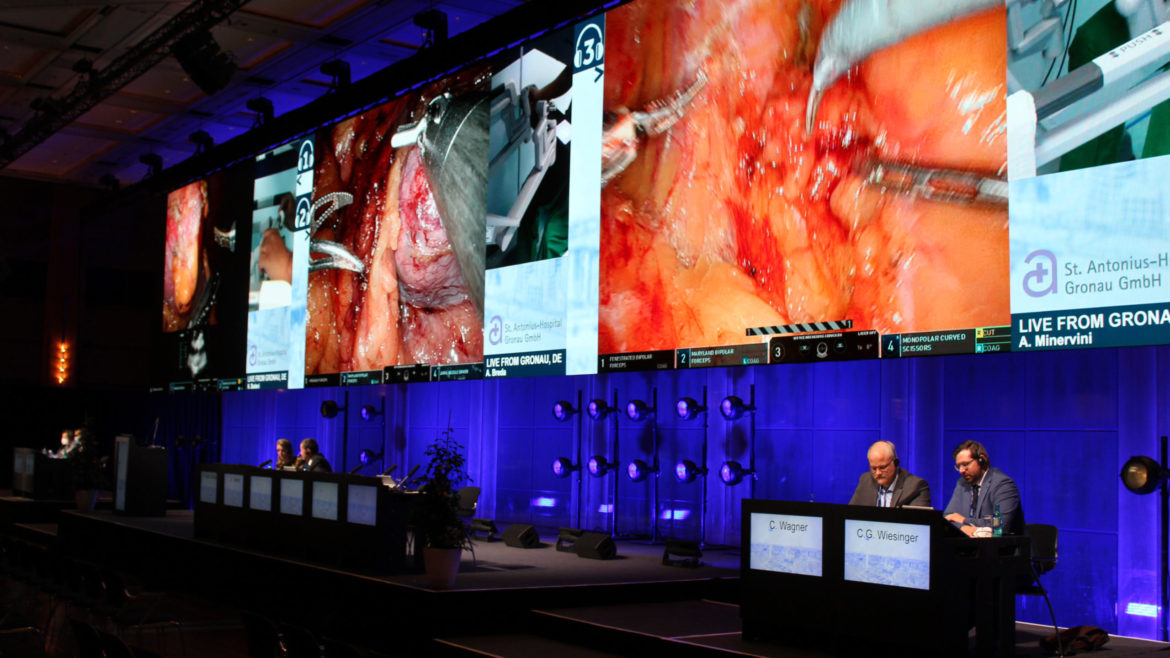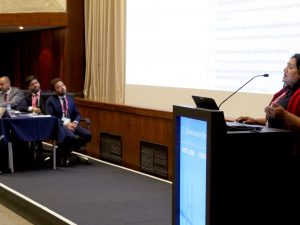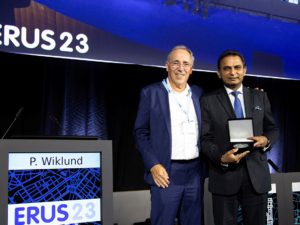Having already been postponed from 2020 to 2021, Dr. Jörn Witt (Gronau, DE) was relieved to have hosted a successful combined Section meeting for robotic urologists in Germany on 11-13 November. The EAU Robotic Urology Section (ERUS) and the German Society of Robotic Urology (DRUS) joined forces for this meeting, attracting both an international audience and a strong local presence of German urologists, nurses and patients.
Nearly 550 people attended ERUS-DRUS21 over those three days. An online option was also offered for people who couldn’t make the trip, but it was the promise of the first face-to-face event in almost two years that led to relief and joy among the participating faculty and delegates.
“We can look back on a very good meeting from a scientific point of view, but also concerning the clinical cases,” said Dr. Witt as the meeting drew to a close. “I’m very proud of the team in Gronau, in particular Dr. Wagner and Dr. Liakos, and everyone involved in organising the meeting in Düsseldorf, as well as my tireless personal secretary.”
“We’d already dealt with postponing the meeting from 2020 to 2021, and this year I was very keen to have a ‘regular’ face to face meeting. We followed all of the local health and safety guidelines and were lucky to hold the meeting while possible.”
Highlights
ERUS-DRUS21 offered delegates a three-day scientific programme filled with eight live surgery sessions, state-of-the-art lectures and many case discussions. Several satellite meetings were offered, such as the Junior ERUS-YAU meeting, which focused on the needs of young urologists, the ERUS-EAUN collaborative meeting with the European Association of Urology Nurses, and a number of German-language meetings for nurses, students and patients. Four courses by the European School of Urology were also available.
Dr. Witt’s highlights from the scientific programme came in surgery: “We saw some complex kidney cases done to a very high level by experienced surgeons. It’s becoming a challenge to see how much you can extend limits in surgical oncology with organ preservation. We also learned some new robotic applications, such as artificial urinary sphincter implantation in females.”
“It’s amazing to see how much robotic surgery has evolved over the past 20 years. Some of this year’s presentations offered some reflection. Robotics has changed urology completely in a relatively short timeframe, in the face of quite a bit of resistance in the beginning. But a good tool cannot be avoided over time.”
ERUS Chairman Dr. Alberto Breda (Barcelona, ES) pointed to the so-called “different ways to skin the cat” approach as a highlight for delegates. The same procedure is carried out by different surgeons, each using their personal technique. “On day one, we had eight radical prostatectomies, as performed by top-rated surgeons. The way they approach the prostate, the little differences, as surgeons we really learn by watching.”
“Another interesting session was when Dr. Ketan Badani performed a very difficult partial nephrectomy. This was a clinical T2 case, and we saw that it is not only feasible but sometimes well indicated to perform partial nephrectomy in T2 settings. We also saw cystectomies, and Prof. Minervini performing a Florence diversion. From him we learned how we could perform an alternative reconstruction of the bladder.”
On the final day, Prof. Henk van der Poel performed an ePLND ICG fluorescence including PSMA tracer-guided robot-assisted surgery. Breda: “This is something we’ve been talking about for a few years now, with encouraging results. There was also a superlative case from Prof. Stöckle, a redo anastomosis after radical prostatectomy. These are tips and tricks that people need to know.”
Dr. Breda was also particularly enthusiastic about the comparison between two ways to perform an intraoperative pathological analysis, be it with a frozen section (NeuroSAFE) or confocal endomicroscopy (VivaScope). Audiences saw Prof. Rocco communicating live with his pathologist (in a “double remote” setting for those watching in Düsseldorf) as a digital reconstruction filled the screen.
“These new techniques will help us select some high-risk patients who could undergo a nerve-sparing procedure even though this is currently not an indication in such a population.”
New robots enter the market
For many years, the theme at ERUS meetings was the development of robotic urology, and in particular the promise of new manufacturers and systems reaching maturity and acceptance in hospitals. It seems 2021 is a breakthrough year, with a huge variety of systems being on-site or demonstrated in (as-)live surgical sessions.
Many participants of ERUS-DRUS21 agreed that we find ourselves in a pivotal time for robotic urology, including Prof. Christian Thomas (Dresden, DE), co-moderator of the 5th live surgery session: “More and more robotic systems are entering the market and we’re seeing that it’s feasible to do procedures like radical prostatectomies or partial nephrectomies to more or less the same standard as the systems we are familiar with.”
“It’s very promising. People are afraid of a learning curve with the new systems, but with the experience we have so far, for experienced surgeons it only takes a few cases to adapt to the new machines. As emerging systems are comparable in terms of functionality, it also becomes a question of economy.”
As robotic systems diversify, what does this mean for training curricula that might be geared to specific companies? Prof. Thomas: “That’s certainly an important factor. Some systems do not yet offer a dual console and I think that’s mandatory for education to become a robotic surgeon.”
Dr. Witt also noted the significance of 2021 as a breakthrough year. “Speaking from both the perspective of ERUS and the German society: we have been waiting for this time to happen for at least 5 years. We hoped that new systems wouldn’t only be in development but finally in clinical use. “We saw the first live cases in Chile and Japan this year. This is a turning point.”
On the potential for a price war, Dr. Witt cautioned that differences might not come in purchase price but in maintenance or the limited-use components. “It’s difficult for a new company to come up with something completely different that’s also better than what we have. It’s a bit like a car. There are a lot of developments but the basic principles stay the same.”
First meeting as chair
ERUS-DRUS21 was also memorable as the first ERUS meeting under the chairmanship of Dr. Breda, who succeeded founding chairman Prof. Mottrie in 2020 (see box).
“Yes, it was a new, big responsibility but I felt well-protected by the EAU’s congress office,” said Breda. “We were in constant contact. The decision to go on-site was only made in September, so we didn’t have a lot of time to pull it off. We did our best, the entire team. There is nobody who didn’t do their job. In the end it paid off. The team from Gronau were excellent in selecting cases. Our audiovisual partner, MediAVentures is a fantastic company. They worked flawlessly and are so professional, you can tell they’ve done this so many times.”
In 2022, it will be Dr. Breda’s turn to host the ERUS meeting in Barcelona. ERUS22 – Barcelona Robotika is set to take place on 5-7 October, with more details to be announced soon. Significantly, Dr. Breda is keen to have the meeting take place on weekdays, hoping for higher attendance figures right until the end of the meeting. “An improved pandemic situation might also allow for more social events, an important component for a meeting of the ERUS family.”
The German Society of Robotic Urology will have its own meeting in Tübingen on 25-26 November, 2022 chaired by Prof. Arnulf Stenzl.
In terms of scientific programme, Dr. Breda thinks live surgery and semi-live cases should be the focus of the ERUS meeting, supplemented with ESU courses where delegates can learn from experts in a more intimate setting. “These courses always throw up a lot of interesting discussions and science. It’s a chance to sit down with expert, and have direct interaction. And that’s just one benefit of having a face to face meeting again!”





